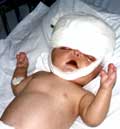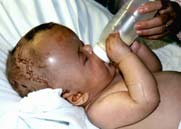 |
 |
|
Apert's & the Enigma of Chromosome No.10
Craniofacial Surgery: Tennessee Craniofacial Center Erlanger Health System Erlanger on Apert: Nat'l Org. for Rare Disorders: Apert's & Related Conditions Craniofacial Work at Columbia: Apert Syndrome: Faces-Cranio Disorders Clinical Variability in Patients: |
A FIRST SURGERY FOR A RARE TIKE ... A TROOPER AND SOLDIER WHO FORTUNATELY WON'T REMEMBER THE EVENT An August Week BY HIS PAPA Early on the morning of August 17, 1999, our Andrew was complaining because we couldn't feed him anything for almost six hours prior to surgery. As the sun rose over University Hospitals, we drove in to admit our son for the operation needed to free Andrew's pair of fused skull plates and move his forehead forward a bit. Without this critically timed procedure, Andrew would likely become mentally retarded, as a developing brain needs room to grow and his fused skull provided no such opportunity. A scheduled 7:30 a.m. surgery got delayed until almost 11 a.m., as a three-year-old girl scheduled for a cleft palette operation the day before got bumped into this morning's first surgical spot. During the wait, our pastor, my sister, my wife's former boss (who happened on by, as he was in for a pacemaker adjustment), and neighbor friends came to join us in the surgical waiting area. Dr. Iskandar notified us around 2:30 p.m. that the surgery was complete. By 4:30 p.m. we would see our brave little boy in the Pediatric Intensive Care Unit (ICU) — almost unrecognizably swollen from head to chin, with a sizable bandage wrap around his skull and arm braces to keep him from touching the area. Thirty-six hours later, he was out of ICU, off of morphine and, miraculously, was only on acetametaphine for pain relief. He was moved into a private room where my wife, Sherri, would stay with him days and I pulled the overnight shift (an infant isn't exactly able to call for a nurse, after all...). The boy who had been known around the house as somewhat cranky by default was now proving himself to be a real trooper. Although he didn't exactly know what all was going on, I admired his steady, accepting spirit, despite hearing little around him and having his eyes swollen shut. As he grew stronger, and as we did likewise Ñ learning how to hold him without disturbing his freshly repaired head and how to bathe his head without adversely affecting the healing of his stitches.
A Tuesday of entry into an uncertain new surgical pasage, to Sunday, when we left for home, with a freshly repaired son, knowing that this was but the first in a litany of surgical procedures to come.
|
|
|
APERT SYNDROME STORIES/SUPPORT Teeter's Page. Major site for Apert links and family-managed Apert ListServ. Apert Chat. Supplement to the Apert ListServ. An Excite community. Apert Support Group at Harvard. Andrea's Page. Personal account from Andrea Gartner, a college student with Apert Syndrome. Amy's Page. Personal account from Amy Esler, a girl with Apert Syndrome. Apert ListServ. An archive of ListServ postings on Apert Syndrome. ApertInfo: Story of Matthew Romero, in conjunction with Children's Hospital of Boston. Thrive Online: A med library article on Apert Syndrome. OTHER RESOURCES (These Links Will Open In New Browser Windows) Swedish Apert Syndrome Informat Medical College of Wisconsin: Apert Overview CCAKids PDF on Apert Syndrome FamilyVillage on Apert's Craniofacial Anomalies:Tooth Formation and Eruption in Patients WideSmiles: Apert Cleft Links |
||
| eXalTerNet | TOP OF PAGE |

